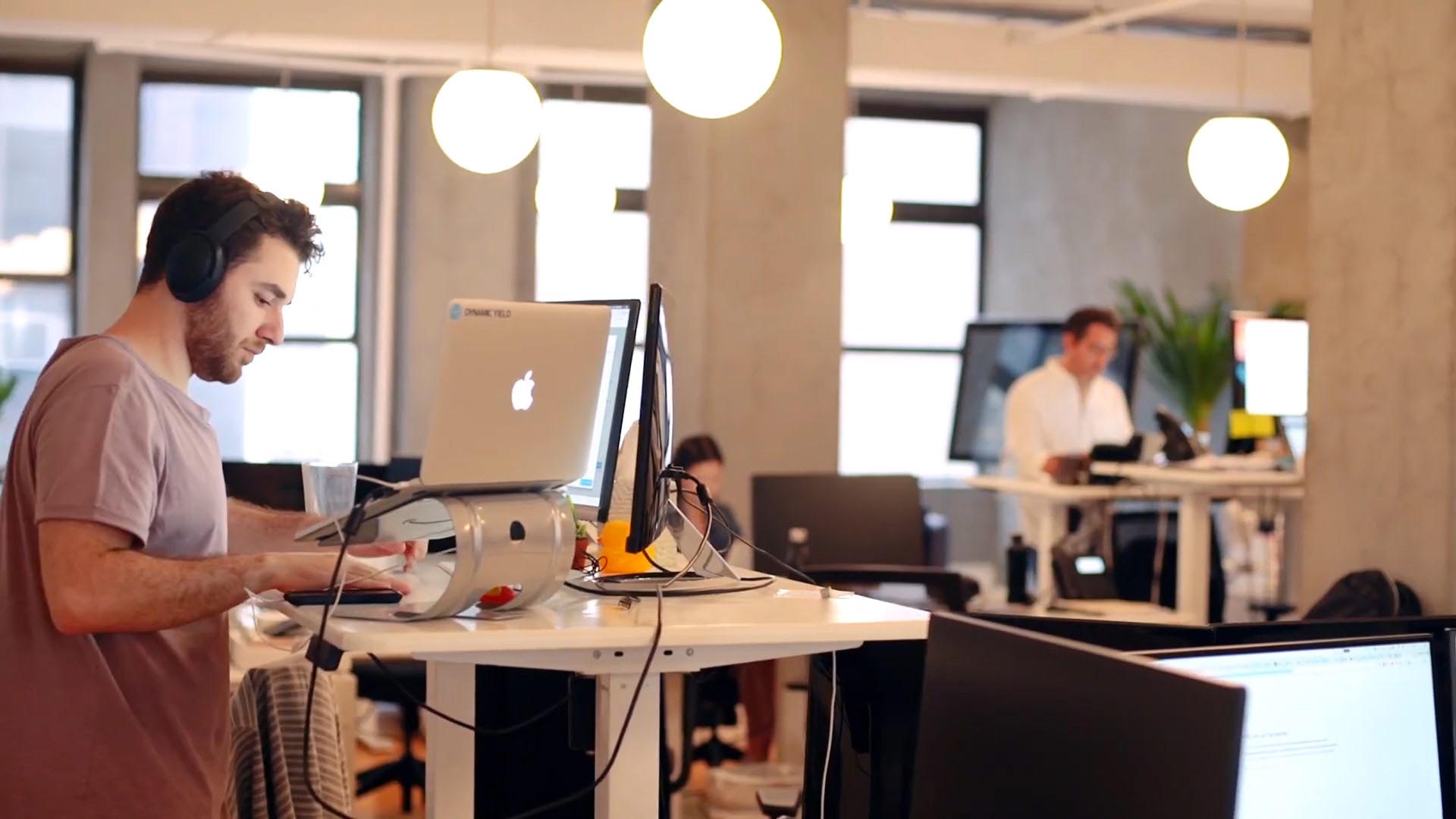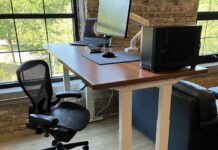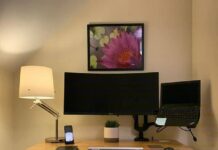It’s no secret that the way we organize and manage offices and work spaces now is changing. Most notably, the amount of new technology entering the workplace is staggering; every day new gadgets and tricks are released that change the way you work. That being said, one of the most crucial parts of the office has been around for decades: the desk. Choosing your desk is a crucial step in solidifying the structure and environment in which you’ll be working.
For many, things like figuring out whether or not you want a specific chair are important parts of the office planning experience, but many are now turning to the debate on whether or not to get a standing desk or not. That begs the question, is a standing desk for you, and what pros and cons should go into your decision?

Standingdesktopper's pick
Pro: Health Benefits
Many studies have been released about the benefits and most share the same conclusion: standing does much more for you than sitting does. Standing does reduce the risk of developing diseases, like diabetes, heart disease, and cancer. Some studies show that working at a standing desk can reduce upper back and neck pain, which are two issues that plague many people as they age into their 40s and 50s. That’s a significant influence on your health for the second half of your life, and if you can help it, you should be doing things to assist your future health. Working at a standing desk for 3-4 hours a day can make a huge difference in terms of how much energy your body is using, and how many calories it is burning. That adds up to about 50 calories a week or the equivalent of running about 10 marathons a year.
Don’t be fooled, that doesn’t replace exercise, but it does make a difference compared to no movement at all. Your heart rate will also become a lower beats per minute ratio, meaning it’s doing less work to keep you alive, signifying strong heart health. With an increased heart rate comes a boost in energy and alertness. Increased heart health eliminates feelings of fatigue brought on by a lack of activity. Plus, standing helps you concentrate on the tasks at hand making you more productive by up to 10%. All of these changes are huge benefits to your health, and your mental health is also going to get a few bumps of improvement.
Your mental health is directly tied to your physical health. When you’re active, your body releases endorphins that stimulate the brain and allow it to function to a closer rate of its peak performance. Physical activity when performed either at great lengths or eve short bursts can do wonders for your mood and energy. These improvements in mood are proposed to be caused by exercise-induced increase in blood circulation to the brain and by an influence on the your brain’s ability to produce emotions of calmness and relaxation, all of which serve as a reactivity to stress. This physiologic influence is probably mediated by the communication of the body with several regions of the brain, including what experts call the limbic part of the brain, which controls motivation and mood; the amygdala portion of the brain, which generates fear in response to stress; and the hippocampus, one you may have heard of, which plays an important part in memory formation as well as in mood and motivation.
There are also benefits to the issue of depression in individuals. Studies show that staying active can help with mild to moderate depression nearly as effectively as an antidepressant medication—but without the side-effects, of course. Sometimes those side effects can be things like fatigue, laziness, and even pain in the body, limbs, and head. In addition to relieving depression symptoms, research also shows that maintaining an exercise schedule can prevent you from relapsing. If medication hasn’t done the trick, or maybe isn’t even doing enough, exercise and activity are the way to turn. The best part is, if you’re too busy to work out, standing at your desk can help with these issues of needing to be more active.
Exercise is a powerful depression fighter for several reasons. Most importantly, it promotes all kinds of changes in the brain, including growth, reduced inflammation, and new activity patterns that promote feelings of calm and well-being. It also releases endorphins, powerful chemicals in your brain that energize your spirits and make you feel good. Finally, exercise can also serve as a distraction, allowing you to find some quiet time to break out of the cycle of negative thoughts that feed depression. If a little break from work is all you need to maybe snap you out of a bad day, you’d be surprised how you might not need that break if you’re at a standing desk. With that set-up, you’re spending your entire day on your feet, which should be telling your brain to be on high alert, and that means even to fend off depression and anxiety.
It’s amazing that the standing desk can do so much from just changing the position in which you work, but there is a con associated that many don’t consider.
Con: Standing does not replace basic nutrition and exercise
There are some who will turn to a standing desk to solve their issues with weight or bad eating habits. For example, if you’re not eating well, telling yourself that it’s okay to eat poorly because you stand at work does not negate the poor nutrition you’re experiencing. For many, poor habits are deeply embedded in their own view of their self, and there are no simple solutions to unhealthy habits. Standing desks, as specified in the previous category of pro, is very much a benefit, but its limitations are plentiful if you’re not eating well and getting exercise outside of work. Don’t let a few small steps forward serve as an excuse for a few hundred steps backward.
It’s also worth noting that diet is the number one cause of obesity and being overweight. If you’re exercising but eating well over your calorie limit, you’re not going to lose weight. That being said, standing will not cancel out a bad diet habit or simply not being mindful with your food.
A lot of people will look at quick fixes or changes as huge influences on their overall health. It is not as easy as just standing if you are looking to lose a significant amount of weight or alter your physical and mental wellness. It is, however, a good start. But don’t expect this to be your ticket to continuing poor choices like overeating or a rejection of exercise. There are a number of things to do and resources to use if you are eager to make significant changes, and while this is a positive one, it will not replace basic nutrition and exercise.
Con: If you’re not in shape, standing can harm you
Keeping the body in an upright position requires a considerable amount of muscular effort. There’s a burden placed on your muscles and bones while standing that is eliminated by sitting. Standing effectively reduces the blood supply to the muscles, meaning that they will start to feel sore fairly quickly, especially if you’re out of shape or overweight. Insufficient blood flow accelerates the beginnings of fatigue and causes immense pain in the muscles of the legs, back and neck. These three areas are where you use your strength most while standing. It’s likely that if you’re not often standing, and then suddenly standing for long periods of time. If you do want a standing desk but don’t get active very often, it’s likely you’ll want to ease yourself into it.
You’ll not only suffer from muscle strain but other discomforts also. Prolonged and frequent standing, without some sort of break or relief by walking, causes blood to build up in the legs and feet, and entire lower body area for all intents and purposes. When standing occurs continually over prolonged periods, especially with those who are overweight, it can result in inflammation of the veins. This inflammation may progress over time to chronic and painful varicose veins. Excessive standing also causes the joints in the spine, hips, knees and feet to become temporarily immobilized or locked. This immobility can later lead to rheumatic diseases due to degenerative damage to the tendons and ligaments. It’s important to note that these threats are often only serious if you have been very inactive, meaning less than 2 hours a day on your feet or working out. If you are relatively on your feet even grocery shopping or walking to a friend’s house, you shouldn’t be at risk for these threats. On the contrary, a pro exists at the other end of this spectrum.
Pro: Standing desks can be your guide to a healthier life
Like stated, it’s honestly only a threat to stand for extended periods of time if you’re inactive. There are signs however that if you are inactive, standing at a desk can be a great gateway into healthier habits and better posture. Posture is something you might not consider to be a part of your health, but bad posture causes real issues like spine warping, neck arthritis, and other serious issues. These often come up later in life, but they’re good to think about now because staying active each day can help eliminate their threats. Standing desks are ideal for ensuring that you stay active throughout the workday. Since they’re positioned much higher than traditional desks, they keep you on your feet and prevent long periods of sitting, which might not be a huge change, but can transition you into healthier lifestyles. Most new standing desk users don’t expect to gain better posture when they make the switch, but many do see change over a relatively small amount of time. This happens naturally because standing up straight mimics the natural and important ways that work toward strengthening your core. If you didn’t have a particularly supportive or ergonomic chair to begin with, you might notice your posture improving even more. Especially if you have not been active, the benefits will roll in immediately and you’ll start to want to be more active.
Conclusion
There are pros and cons associated with standing desks, and there’s a way to manage both. Having a desk that allows you to choose when to stand and when to sit can make a huge difference. You can choose to be standing for 4 hours of the day, and sitting for 4, and you might even find that you enjoy standing more as you get used to it, and eventually, you can just sit when you need a break. Many desks allow you to adjust the height, but it is also common to want to do less work, especially when you’re already focused on work. There is a desk that does the work for you, and it’s perfect for any office, from the traditional office to a home workspace.
How do you know if a standing is for you? Only you can answer that. Take this article and its pros and cons and see what you think works best for you. A standing desk does have its downfalls, but it’s also a great way to stay active. For the option, a desk that can both allow you to sit and stand is the way to go because you can decide from day to day. That’s a custom option for you to make each day, and if you have a desk that can do that, it leaves it up to you and how you feel in the moment. The physical benefits are plentiful, but there are risks involved as well. In choosing a standing desk, it’s possible you may be making a decision that helps your health, but you also need to be careful.
Talk with your coworkers and see what they think, maybe you could all take the standing desk challenge and get out of your seat and on your feet. Stand responsibility






